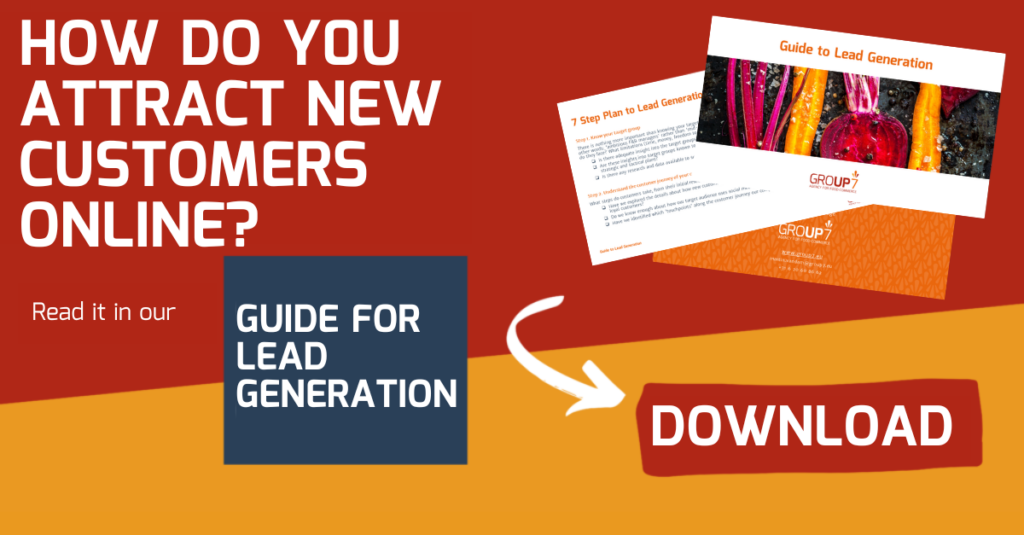Lead generation is the process of identifying potential customers and arousing their interest in an organization’s products or services. It is the act of eliciting initial contact with people or companies that may be interested in your product or service.
Unfortunately, you cannot tell from someone’s IP address whether they are interested in your product or service. In fact, with increasing privacy legislation, you will soon no longer be allowed to view someone’s data without his or her permission. The moment when an unknown person becomes a lead is therefore in the hands of that other person.
So when you focus on lead generation, you try to provoke the first interaction with your potential customer. You set this up in a way so that you receive some information from that person, possibly learn something about his interests and, with a bit of luck, get permission to include him further in mailings. From that moment on, the lead generation topic is also closed and the process of lead nurturing begins, i.e. developing a new customer.
In this blog we discuss seven mistakes that we often see in lead generation:
- Not targeting the right people
- Do not personalize or segment
- No or irrelevant landing pages
- Weak lead generation forms
- Too much manual work
- Putting your identity aside.
- No follow-up through a lead nurturing process
1. Not targeting the right people
Not every contact you add to your list is useful. For example, the majority of exposure places are aimed at consumers. For you as a B2B food service party, there are many visitors with whom you cannot do business. So be as specific as possible when choosing the place where you are visible, and where possible to which audience you are visible. If one of your snacks is in the spotlight, you want cafeteria operators to see you, but restaurant buyers who also appear on a catering platform will not find your message relevant.
Basically, good targeting starts with good research into your target group. You need to find out what your customers’ problems are and what solutions they are looking for, solutions that you can help them with. You then investigate how your target group orients and purchases its solution, and what role social media, mobile apps, trade media, wholesalers or other channels play in this.
2. Not personalizing or segmenting
To include people in your message, the reader, viewer or listener must feel addressed. He or she must get the idea that the message will solve his or her problems. With an overload of commercial messages that people receive every day, they become frustrated by offers and promotions that do not match their interests.
To achieve extensive personalization, you need a lot of background information about your visitor. You generally don’t have that yet. Visitors to online content are often strangers to you. But you do know why they look for relevant content in a certain place. So you can also give it a personal twist. On a snack page you can feel free to ask whether someone is from team croquette or team frikandel, you don’t do that on a banner at Misset Horeca. In the latter case, when the target group can be a bit broader, you use your ideal lead. Because you want to address them. It is a shame that a less relevant lead does not feel addressed, but it is not the end of the world. So you will occasionally be wrong in your personalization and that is not a problem. Better that than not being noticed by your desired target group as a gray mouse.
3. No or irrelevant landing pages
If your lead generation starts with a post on one of your social media channels, or with a banner on a trade website, you are trying to create an atmosphere and convey a message with that banner. The banner or post contains a call to action, often in the form of “click here for..”. So you want that when people click, they also end up with what you have presented to them.
If you lure people with something, you have to make it happen within a few seconds. People don’t have patience, don’t scroll, don’t search, don’t click, if the beginning is not relevant. So letting people land on your homepage, “because from there they can find everything they want to know”, will not yield you much. Someone has to be very bored with their current job before they start navigating through your site.
You create a separate landing page per campaign or per advertisement where direct conversion can take place, so a form can be filled out or an order can be placed. Furthermore, the benefits of your solution are mentioned again on the landing page, of course because it is the best solution for a problem your reader has. And yes, he has. Because otherwise he wouldn’t have clicked through.
4. Weak lead generation forms
You can request information from your lead via a form. Please note that people drop out when they have to hand over too much of their data. Leaving an email address is often fine, they calculate that they can receive emails. They probably give permission for that. Giving a name is also nice, because in the context of personalizing point 2, I receive an email with “Dear” above it and that feels nice. But if I download a whitepaper, why should I provide my address? They don’t send it in the mail, do they?

We know from research that with more than 5 fields, the willingness to complete a form becomes much lower. You can see it in the graph above. Longer forms can work if the value you get in return is also higher, such as a free sample. It then feels much more logical to have to enter an address and perhaps also a telephone number. In short, when you have more value to offer, your visitor will also be willing to give up more of his or her personal data.
5. Too much manual work
You really don’t want all those generated leads to have to be processed manually. A request comes in via your website, you have to put it in a spreadsheet, you have to see whether it is someone who qualifies as a lead, you have to see how you can follow up on him and therefore which nurture route you are going to choose. And when you have finally put all that right, the next request will come in again.
In a good CRM and Marketing Automation system you work with tags and (control) questions to qualify your lead and thus automatically start your follow-up. This way you can map out the routes and your software determines how the lead moves towards you and which nurture flows it will follow.
6. Putting your identity aside.
The principle is very simple, but it is a tempting mistake to make. For your first meeting, you pretend to be slightly different than you are. That’s something that might work in the short term, but if leads come to you with the wrong expectations, you won’t be able to keep them happy for long. And they will probably leave you again as your normal brand identity comes to the fore.
From practice: This summer we looked at a customer’s lead generation and lead nurturing processes. Part of this was to encourage purchase by using a promotion, in this case a discount. But we came back to this during the working session with this producer, because discounts did not fit the brand image of this company. For example, a free premium with an order, such as extra decorative material to make the basic product more personal, would be more suitable.
Remember: Leads that you attract with a discount will continue to expect discounts from you. Leads who come to you for a welcome gift want an “extension gift” again after a year. You cannot ignore leads that you find on the basis of personal advice or a representative visit after a first visit.
So be aware that after “winning” a contact, a long-term program also follows to remove a customer from your lead. And the easiest way to do that is with a consistent brand message.
7. No follow-up through a lead nurturing process
As mentioned before, finding new, valuable leads is not the end point. However, the process of lead generation does stop there, and far too often we see that paying attention to that lead also ends there. It is really no exception if you have received a list of addresses at, for example, a trade fair or from an event in which you have participated, that you have neatly entered those addresses in your CRM and parked them for when they are relevant to use. But then realize, when you obtained data, we were dealing with engaged leads. Warm leads. The longer you let them cool down, the more difficult it becomes to get them enthusiastic about your campaigns again.
Get started yourself
Now that we have taken you through the seven common mistakes we encounter, and you have read back what we wrote earlier about lead generation, you can basically get started yourself. We have a handy tool for this, a checklist for lead nurturing in which the tips from this and previous articles can be conveniently ticked off. Check what you are already working on and what you can still improve as you go through the list.
If you have any questions about something specific regarding lead generation, you can always contact us.



